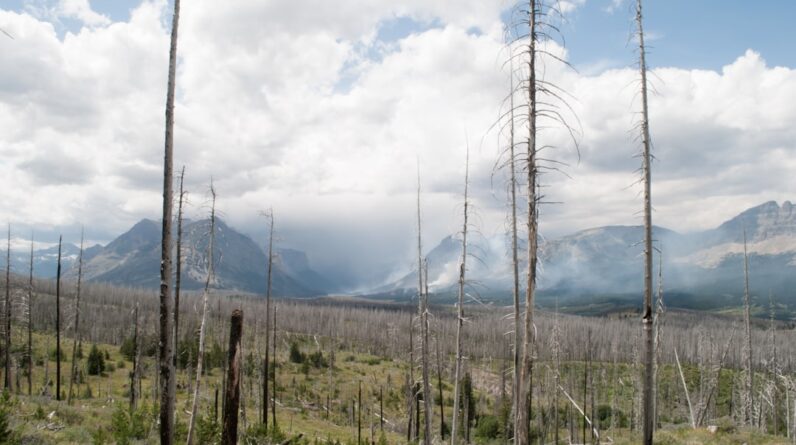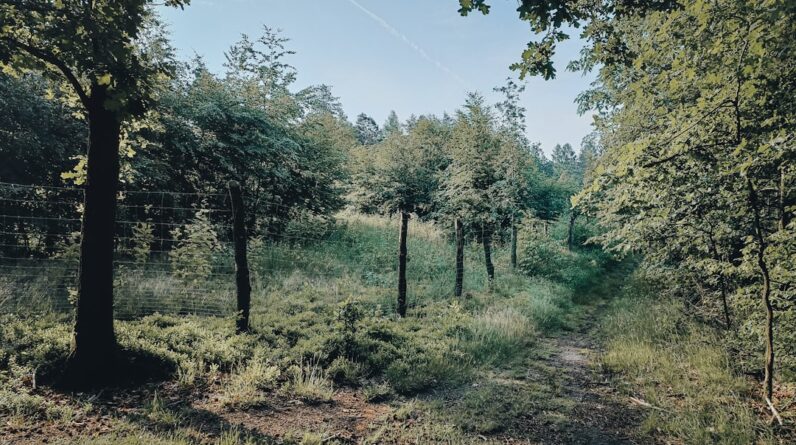
As you delve into the intricate relationship between climate change and forests, it becomes evident that these ecosystems are among the most affected by rising global temperatures. Forests, which serve as vital carbon sinks, are increasingly under threat from extreme weather events, shifting precipitation patterns, and invasive species. You may notice that the very fabric of these ecosystems is being altered, leading to changes in species composition and forest health.
For instance, prolonged droughts can weaken trees, making them more susceptible to pests and diseases, while intense storms can cause significant physical damage to forest structures. Moreover, the impact of climate change on forests extends beyond immediate physical damage. You might observe that altered climatic conditions can disrupt the delicate balance of forest ecosystems, affecting everything from soil health to wildlife habitats.
As temperatures rise, certain tree species may struggle to survive in their traditional ranges, leading to shifts in forest composition. This not only affects biodiversity but also has far-reaching implications for the services forests provide, such as clean air and water, climate regulation, and recreational opportunities. Understanding these dynamics is crucial for developing effective strategies to protect and restore forests in a changing climate.
Key Takeaways
- Climate change is causing significant impacts on forests, including increased frequency of wildfires, insect outbreaks, and extreme weather events.
- Reforestation plays a crucial role in mitigating climate change by sequestering carbon dioxide and restoring ecosystem services.
- Selecting the right tree species for reforestation in a warming world is essential for ensuring the long-term success and resilience of reforested areas.
- Implementing sustainable reforestation practices, such as agroforestry and mixed-species planting, can enhance the ecological and socio-economic benefits of reforestation efforts.
- Integrating indigenous and local knowledge in reforestation strategies can help enhance biodiversity, resilience, and cultural significance of reforested areas.
The Importance of Reforestation in Mitigating Climate Change
Reforestation emerges as a powerful tool in the fight against climate change, offering a multifaceted approach to sequestering carbon and restoring ecological balance. When you consider the sheer volume of carbon dioxide that trees absorb during their growth, it becomes clear that reforestation can play a significant role in offsetting greenhouse gas emissions. By planting trees in deforested or degraded areas, you contribute to the restoration of carbon sinks that have been compromised by human activity.
This not only helps mitigate climate change but also enhances the resilience of ecosystems. In addition to carbon sequestration, reforestation provides a host of other environmental benefits. You may find that restored forests improve soil quality, enhance water retention, and reduce erosion.
These ecosystems also serve as habitats for countless species, promoting biodiversity and supporting wildlife populations. Furthermore, reforestation can have socio-economic benefits for local communities by providing resources such as timber, non-timber forest products, and recreational opportunities. By engaging in reforestation efforts, you are not only addressing climate change but also fostering sustainable development and improving the quality of life for people who depend on these ecosystems.
Selecting the Right Tree Species for Reforestation in a Warming World

Choosing the appropriate tree species for reforestation is a critical step in ensuring the success of your efforts in a warming world. As you embark on this journey, it is essential to consider factors such as climate adaptability, growth rates, and ecological compatibility. You may want to prioritize native species that are well-suited to local conditions and have co-evolved with the surrounding flora and fauna.
These species often possess traits that enhance their resilience to climate stressors, making them more likely to thrive in changing environments. In addition to native species, you might also explore the potential of climate-resilient tree varieties that can withstand higher temperatures and altered precipitation patterns. This approach requires careful research and consideration of future climate scenarios to ensure that the selected species will remain viable over time.
You may also want to engage with local experts and ecologists who can provide valuable insights into the best species for your specific reforestation project. By making informed choices about tree species, you can enhance the likelihood of successful reforestation and contribute to the long-term health of forest ecosystems.
Implementing Sustainable Reforestation Practices
As you move forward with your reforestation initiatives, implementing sustainable practices is paramount to ensuring the longevity and health of newly planted forests. Sustainable reforestation goes beyond merely planting trees; it encompasses a holistic approach that considers ecological integrity, social equity, and economic viability. You might begin by assessing the site conditions and understanding the local ecosystem dynamics before initiating any planting activities.
This groundwork will help you identify potential challenges and opportunities for creating a thriving forest. One key aspect of sustainable reforestation is maintaining biodiversity within your planting efforts. You may choose to adopt mixed-species planting strategies that mimic natural forest structures, which can enhance resilience against pests and diseases while providing diverse habitats for wildlife.
Additionally, incorporating agroforestry practices can create synergies between tree planting and agricultural activities, allowing local communities to benefit from both forestry and farming. By prioritizing sustainability in your reforestation practices, you not only contribute to climate change mitigation but also foster healthy ecosystems that can thrive for generations to come.
Integrating Indigenous and Local Knowledge in Reforestation Strategies
Incorporating indigenous and local knowledge into your reforestation strategies can significantly enhance the effectiveness and cultural relevance of your efforts. Indigenous communities have long-standing relationships with their environments and possess invaluable insights into local ecosystems, including traditional practices for land management and species selection. By engaging with these communities, you can gain a deeper understanding of the ecological context in which you are working and identify culturally significant species that may be overlooked in conventional approaches.
You might also find that integrating local knowledge fosters community ownership and stewardship over reforested areas. When local people are involved in decision-making processes and see their traditional practices respected, they are more likely to invest time and resources into maintaining these newly established forests. This collaborative approach not only strengthens social ties but also enhances the resilience of reforested areas by ensuring that they are managed in ways that align with local customs and ecological wisdom.
By valuing indigenous knowledge alongside scientific research, you create a more inclusive framework for successful reforestation.
Enhancing Biodiversity and Resilience in Reforested Areas

As you embark on your reforestation journey, enhancing biodiversity within newly established forests should be a primary goal. Biodiversity plays a crucial role in ecosystem resilience, allowing forests to adapt to changing conditions and recover from disturbances more effectively. You may consider implementing strategies such as planting a diverse array of tree species, incorporating understory plants, and creating varied habitat structures that support different wildlife populations.
This diversity not only enriches the ecosystem but also contributes to its overall stability. In addition to promoting biodiversity through species selection, you might explore ways to create connectivity between reforested areas and existing natural habitats. Establishing wildlife corridors can facilitate animal movement and gene flow between populations, enhancing genetic diversity and resilience against environmental changes.
You may also want to monitor the ecological health of your reforested areas over time, assessing factors such as species richness and ecosystem functions. By prioritizing biodiversity in your reforestation efforts, you contribute to creating robust ecosystems capable of withstanding the challenges posed by climate change.
Monitoring and Evaluating the Success of Reforestation Efforts
Monitoring and evaluating your reforestation efforts is essential for understanding their effectiveness and making necessary adjustments over time. As you implement your project, consider establishing clear metrics for success that align with your goals—whether they involve carbon sequestration rates, biodiversity indices, or community engagement levels. Regular assessments will allow you to track progress and identify any challenges that may arise during the growth of your newly planted trees.
You might also engage with local stakeholders during the monitoring process to gather feedback and insights on how the reforested areas are impacting their lives and environments. This collaborative approach not only strengthens community ties but also fosters a sense of shared responsibility for maintaining these forests. By continuously evaluating your reforestation efforts, you can adapt your strategies based on real-world outcomes, ensuring that your initiatives remain relevant and effective in addressing both climate change and local needs.
Collaborating with Communities and Stakeholders for Successful Reforestation
Collaboration is key to achieving successful reforestation outcomes that benefit both ecosystems and communities alike. As you embark on this journey, consider building partnerships with various stakeholders—including local governments, non-profit organizations, businesses, and community groups—to leverage resources and expertise. Engaging diverse perspectives can enrich your understanding of local needs while fostering a sense of collective ownership over reforestation initiatives.
You may also want to prioritize education and outreach efforts within communities to raise awareness about the importance of forests in combating climate change. By organizing workshops or community events focused on tree planting and forest stewardship, you can empower individuals to take an active role in protecting their environment. Collaboration not only enhances the effectiveness of your reforestation efforts but also cultivates a culture of environmental stewardship that can endure long after your project concludes.
Through shared commitment and collective action, you can create lasting positive impacts on both forests and communities in a warming world.
Climate-Proofing Forests: Reforestation Strategies for a Warming World is a crucial topic in today’s environmental discussions. However, it is important to consider the potential consequences of increased tree planting on the world’s ecosystems. According to a related article on Live Life with a Cause, planting too many trees can actually unbalance ecosystems and have negative impacts on biodiversity. It is essential to strike a balance between reforestation efforts and preserving the delicate balance of nature.
FAQs
What is climate-proofing forests?
Climate-proofing forests refers to the process of implementing strategies to help forests adapt to and mitigate the effects of climate change. This can include reforestation efforts, forest management practices, and conservation measures aimed at increasing the resilience of forests in a warming world.
Why is reforestation important for climate-proofing forests?
Reforestation is important for climate-proofing forests because it helps to restore and expand forest cover, which can provide numerous benefits for mitigating climate change. Trees absorb carbon dioxide from the atmosphere, helping to reduce greenhouse gas emissions, and also provide important ecosystem services such as regulating water cycles and providing habitat for wildlife.
What are some reforestation strategies for a warming world?
Reforestation strategies for a warming world can include planting tree species that are more resilient to climate change, restoring degraded forest areas, implementing agroforestry practices, and creating forest corridors to facilitate species migration in response to changing climate conditions.
How can reforestation help mitigate the effects of climate change?
Reforestation can help mitigate the effects of climate change by sequestering carbon dioxide from the atmosphere, reducing the impacts of deforestation and forest degradation, and providing important ecosystem services such as regulating water cycles and reducing soil erosion.
What are the challenges of climate-proofing forests through reforestation?
Challenges of climate-proofing forests through reforestation can include limited resources, competing land uses, invasive species, and the need to consider the potential impacts of climate change on tree species selection and forest management practices. Additionally, ensuring the long-term success of reforestation efforts requires careful planning and monitoring.





